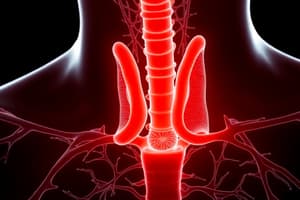Podcast
Questions and Answers
What is the role of TRH and TSH in the control of thyroid hormone production?
What is the role of TRH and TSH in the control of thyroid hormone production?
Stimulate
What is the main effect of high levels of TSH on the thyroid gland?
What is the main effect of high levels of TSH on the thyroid gland?
Enlargement
How do anti-thyroid drugs work in the treatment of hyperthyroidism?
How do anti-thyroid drugs work in the treatment of hyperthyroidism?
Inhibiting thyroid peroxidase (TPO)
What is the main function of T4 in the context of thyroid hormones?
What is the main function of T4 in the context of thyroid hormones?
What is the effect of TRs binding T3 in target cells?
What is the effect of TRs binding T3 in target cells?
What is the result of peripheral conversion of T4 in extrathyroidal tissues?
What is the result of peripheral conversion of T4 in extrathyroidal tissues?
What are the two main hormones secreted by the posterior pituitary gland?
What are the two main hormones secreted by the posterior pituitary gland?
Explain the role of oxytocin in parturition.
Explain the role of oxytocin in parturition.
What is the significance of suckling-induced neuroendocrine reflexes?
What is the significance of suckling-induced neuroendocrine reflexes?
How are thyroid hormones synthesized in the thyroid gland?
How are thyroid hormones synthesized in the thyroid gland?
Where are thyroid hormones stored before secretion into the blood?
Where are thyroid hormones stored before secretion into the blood?
How is the hypothalamic-pituitary-thyroid axis controlled?
How is the hypothalamic-pituitary-thyroid axis controlled?
Describe the control of oxytocin secretion and its effects in parturition and lactation.
Describe the control of oxytocin secretion and its effects in parturition and lactation.
Explain the concept of suckling-induced neuroendocrine reflexes.
Explain the concept of suckling-induced neuroendocrine reflexes.
How is thyroid hormone biosynthesis regulated?
How is thyroid hormone biosynthesis regulated?
Explain the process of thyroid hormones storage in the follicle lumen.
Explain the process of thyroid hormones storage in the follicle lumen.
Describe the control of the hypothalamic-pituitary-thyroid axis.
Describe the control of the hypothalamic-pituitary-thyroid axis.
Explain the significance of the structural and functional relationship between the hypothalamus and pituitary gland in the context of neuroendocrine control.
Explain the significance of the structural and functional relationship between the hypothalamus and pituitary gland in the context of neuroendocrine control.




